Italian Civil Records in New and Updated Genealogical Collections
Italian civil records at FamilySearch have been updated for five specific localities. Births, marriages, and deaths are just a few of things you will find in these collections. Also this week, Netherlands, Sweden, Australia, and Alaska.
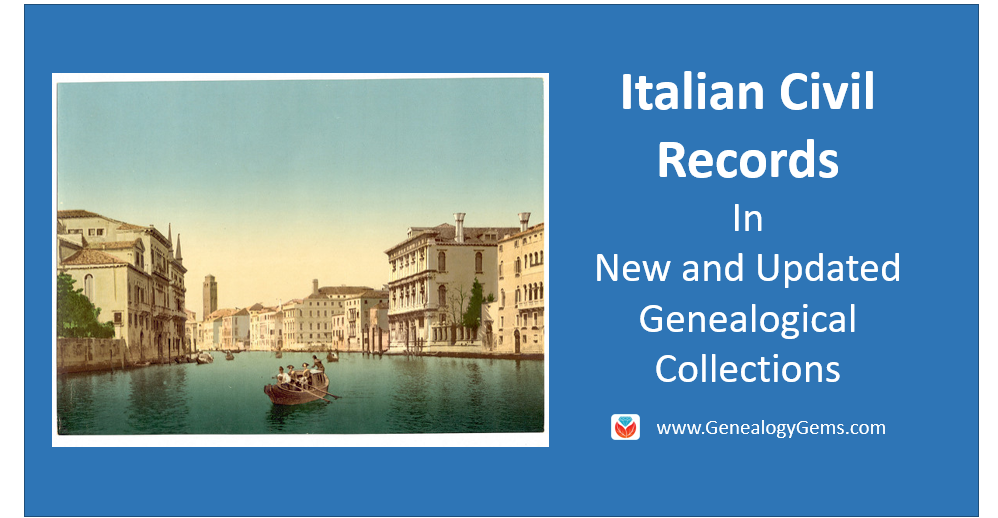
Italy – Italian Civil Records
FamilySearch has added to their Italian genealogy records this week. Five specific locales in Italy have Civil Registration records online. Civil registrations include such things as births, marriages, and deaths. They can also include marriage banns and ten-year indexes. Of course, availability of records will depend on the time period and the location.
The first collection titled Italy, Viterbo, Civil Registration (State Archive), 1870-1943 cover the years of 1870-1943.
This collection may include the following records:
- Marriage banns (pubblicazioni o notificazioni)
- Residency records (cittadinanze)
- Ten-year indexes (indici decennali)
- Supplemental documents (allegati)
The second collection titled Italy, Mantova, Civil Registration (State Archive), 1496-1906 covers several centuries. Images for this collection had been mistakenly made available to the general public who registered at FamilySearch. However, because of the agreement signed 30 June 2011, the publication rights of images belongs to the Italian National Archives (DGA) who publishes them freely to all on their Portale degli antenati: http://www.antenati.san.beniculturali.it/. Though you can see a transcript of the civil record at FamilySearch, you will have to visit the Il Portale Antenati to see the digital images. Some fees may apply.
Again, these civil records for Mantova will include such things as birth, marriage, and death records and in some cases, marriage banns and 10-year indexes.
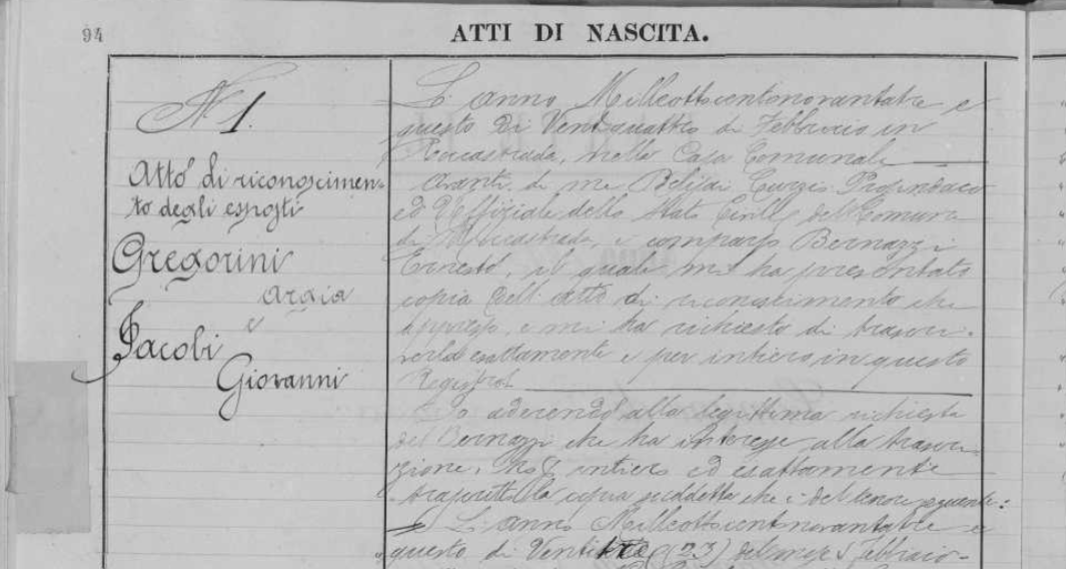
Italian birth record online at FamilySearch.
The third collection is titled Italy, Grosseto, Civil Registration (State Archive), 1851-1907. These records will again cover birth, marriages, and deaths in the Grosseto locale. These records, like the others, are written in Italian. In this case, you are able to view many of the digital images online at FamilySearch without having to use the Portale Antenati.
The fourth collection titled Italy, Rieti, Civil Registration (State Archive), 1840-1945 covers the years between 1840 and 1945 of this specific locale. The records held in this collection will largely be the same as the others, but there is something special that these Rieti records hold. They include Catholic parish registers of Poggio Fidoni (Frazione of Rieti) for the years 1768-1860.
Lastly, a fifth collection titled Italy, Enna, Civil Registration (State Archive), 1866-1944 has also been added with lots of birth, marriage, and death records for the vicinity of Enna.
For more details about the contents of all these record sets, their history, and help using them, see the wiki article: Italy, Civil Registration (FamilySearch Historical Records).
Netherlands – Miscellaneous Records
Also at FamilySearch, records have been added to the Netherlands, Archival Indexes, Miscellaneous Records. These miscellaneous records include indexes that cover many record sources, such as civil registration, church records, emigration lists, military registers, and land and tax records. These records cover events like birth, marriage, death, burial, emigration and immigration, military enrollment, and more.
Sweden – Norrbotten Church Records
Sweden, Norrbotten Church Records, 1612-1923; index 1658-1860 is a recently updated collection at FamilySearch as well. Church records from the county of Norrbotten contains indexes to births, marriages, deaths and images to clerical surveys, registers of birth, marriage, death, move-in and move-out lists, confirmations, and church accounts. Notice that this collection has some index-only items and there are some other items that offer a digital image of the record. Covering such a lengthy period of time, records will vary given the time frame.
The records are handwritten in narrative style and may be difficult to research for beginners.
Australia – Marriages
This week at Findmypast, we bring your attention to Australian Capital Territory Marriages. Each record result contains a transcript of the original record. The information available will vary, but information typically includes:
- First and last name
- Marriage date
- Spouse’s first and last name
- Registration number
- State
Further details can be found on the marriage certificate itself, which can be obtained online from the Office of Regulatory Services. Due to the sensitivity of the information found on marriage certificates, the marriage must have occurred more than 75 years ago to obtain a certificate.
Australia – Victoria – Wills & Probate
Wills and other probate records are a fantastic resource for genealogists. They often contain names of heirs and prove relationships. Findmypast has updated the collection titled Victoria Wills & Probate. In this collection of mostly indexed records, some search results will also include an image of the original probate documents. Records cover the years 1841 to 1989 and may include the following information:
- First and last name
- Sex
- Occupation
- Residence
- Death date
- Grant date
- File number
Australia – Victoria – Divorce Records
The Victoria Divorce Cause Books 1861-1938 collection at Findmypast may offer you answers to the reason your ancestors parted ways. In Victoria, the Public Records Office Victoria (PROV) holds divorce case records up to 1940. If you are interested in more recent divorce cases, you will need to contact the Supreme Court of Victoria. It’s important to also know that up until 1975, divorce cases in Victoria were heard by the Supreme Court.
 These records will likely provide you with the first and last names of couples, petition date, who filed for divorce, and a case file number.
These records will likely provide you with the first and last names of couples, petition date, who filed for divorce, and a case file number.
United States – Alaska – Vital Records
Did you know that this year is the 150th anniversary of the Alaskan Purchase? We have some great tips for Alaskan genealogy research coming up here on the blog in the next couple of weeks. In the meantime, get started on researching your Alaska ancestors with the FamilySearch collection titled Alaska, Vital Records, 1816-1959.
In these records, images of birth, marriage, death, and divorce records are available for searching. Though the collection is a bit on the small side, new records will be added as they become available. Digital images of births cover the years of 1816 to 1912, marriages for the years of 1816 to 1959, and deaths between 1816 and 1959.
More on Italian Civil Records and Research
Mary Tedesco of Genealogy Roadshow (on PBS in the US) talks about doing the show and her tips for doing Italian genealogy research on our Genealogy Gems YouTube Channel. Watch the clip below and be sure to subscribe to our channel so you don’t miss any of our helpful tips and tricks. Thanks for watching, friends.
Trace Your Irish Ancestors with Four Historical and Geographical Tips
Let’s trace your Irish ancestors! Irish research tips are a must-have for this historically violent little island. Senior Researcher at Legacy Tree Genealogists, Kate Eakman, shares with you four historical and geographical tips to get you off to the right start.
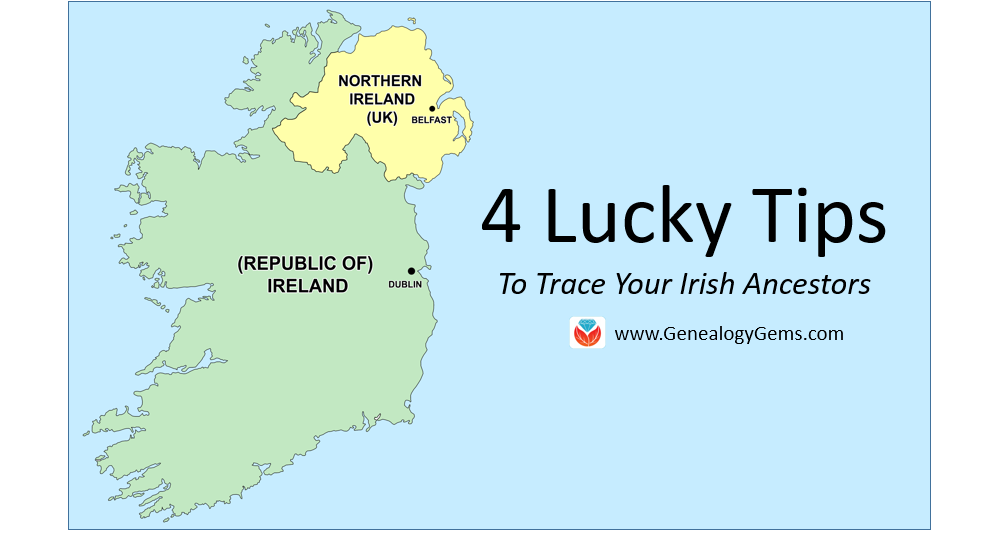
By Jonto at English Wikipedia [GFDL (http://www.gnu.org/copyleft/fdl.html) or CC-BY-SA-3.0 (http://creativecommons.org/licenses/by-sa/3.0/)], via Wikimedia Commons
Trace Your Irish Ancestors: 4 Tips

Kate Eakman from Legacy Family Tree Genealogists
Irish research can be difficult. Although the island is small–about the same size as the state of Indiana–its violent history and many divisions makes research complicated. In addition, many United States records simply report our ancestors were from Ireland with no indication of the county of their birth. However, knowing a little bit about the history and geography can provide the necessary clues. Here are four tips that can help you trace your Irish ancestors from the United States back to Ireland.
Tip 1: Understand the Island of Ireland Today
There are two distinct political entities on the island of Ireland: Northern Ireland and the Republic of Ireland. The dividing line was drawn by England in 1922. This is an important date to keep in mind when searching for more recent Irish ancestors.
The Republic of Ireland, or Eire, is an independent nation made up of the southern 26 counties of Ireland. The Republic of Ireland is predominantly Catholic, with about 3% of the population identifying itself as Protestant. Indices and links to copies of the civil birth records for the years 1864 to 1915, marriages between 1882 and 1940, and death records between 1891 and 1965 are available for free from the IrishGenealogy website. (These records include those of the Northern Irish counties up to 1922.) Official copies can be ordered from the General Records Office in Dublin.
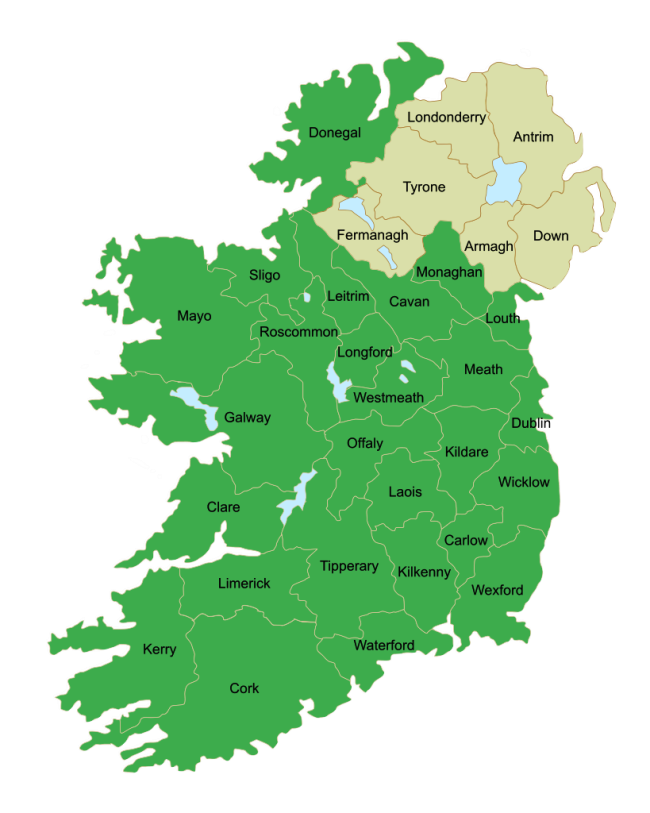
Map of the counties of Northern Ireland and the Republic of Ireland. Photo courtesy https://commons.wikimedia.org.
Northern Ireland, also known as Ulster, is a part of the United Kingdom–although it is self-governing like Canada or Australia. Although the counties of Northern Ireland are not officially used today, it is comprised of the traditional counties of Antrim, Armagh, Down, Fermanagh, Tyrone, and Londonderry (also known by the more traditional name of Derry). Although most Americans believe that Northern Ireland is a Protestant nation, the reality is that today there are almost an equal number of Catholics as there are Protestants in Northern Ireland. Civil birth, marriage, and death records can be ordered from GRONI (General Records Office Northern Ireland).
Tip 2: Turn to U.S. Census Records
From the 1880 U.S. Census through the 1920 U.S. Census, Irish ancestors who immigrated to the United States, or whose parents were natives of Ireland, simply reported they were natives of Ireland. However, since the 1930 U.S. Census was taken after the creation of the Republic of Ireland in 1922, it often noted the specific country from which ancestors originated.
In this sample (below) from the 1930 U.S. census, we can see John O’Reilly was born in “North. Ireland,” as were his mother and her parents. His father, however, was from the Irish Free State, or the Republic of Ireland. This information tells us where to search for John’s birth: in one of the six counties of Northern Ireland. His mother’s birth record will also be from Northern Ireland, and probably his parents’ marriage record also, since it is more traditional to marry in the bride’s hometown than the groom’s.
There is the potential that a much larger search will be necessary for John’s father’s birth record unless the marriage record can be found and it specifies in which of the 26 Republic of Ireland counties he was born.

John J. O’Reilly and his mother in the 1930 U.S. Census report. The detail shows where John was born, then his father’s place of birth, followed by his mother’s place of birth. The second line was the same information for John’s mother. Images courtesy http://ancestry.com.
If your Irish ancestor, or the child of that ancestor, is listed in the 1930 U.S. census, pay close attention to where they reported they and their parents were born. You might find a very helpful clue in that census report.
Tip 3: Look to Religion for Clues
While many people associate Roman Catholicism with Ireland, there are many Protestants living in Northern Ireland and fewer in the Republic of Ireland. Knowing your family’s historical religious preference can provide a small hint. If your family has always been Catholic it is likely they were Catholics in Ireland. However, as we have already noted, with almost all of the Republic of Ireland expressing a preference for Catholicism and about 45% of the citizens of Northern Ireland claiming allegiance to the Catholic faith, you can see a Catholic religious heritage is not particularly unique.
However, if your family history includes the Episcopal faith, or there is something that references “the Church of Ireland” in your family’s records, then your family was most likely Protestant when they lived in Ireland. You are also more likely to find your Protestant ancestors in Northern Ireland (with the understanding that there are Protestants throughout the Republic of Ireland).
If your family is or has been Presbyterian, there is a very strong likelihood your family is actually Scots-Irish with your ancestors immigrating to Ireland from Scotland, bringing their Scottish religion with them. You will find most of these ancestors in Northern Ireland.
Tip 4: Move on to Military Records
World War I (1914-1918) was particularly brutal to the Irish. More than 30,000 of the 200,000 men who enlisted were killed in this war. Songs such as “Gallipoli” and “The Foggy Dew” mourned the loss of so many young Irish men in foreign wars, especially since the 1922 Irish War of Independence followed closely on the heels of World War I.
If one of your Irish ancestors fought and died in World War I, you can find his name and more at the website Ireland’s Memorial Records. Many (but not all) of the memorials include the county in which the soldier was born, as seen below:
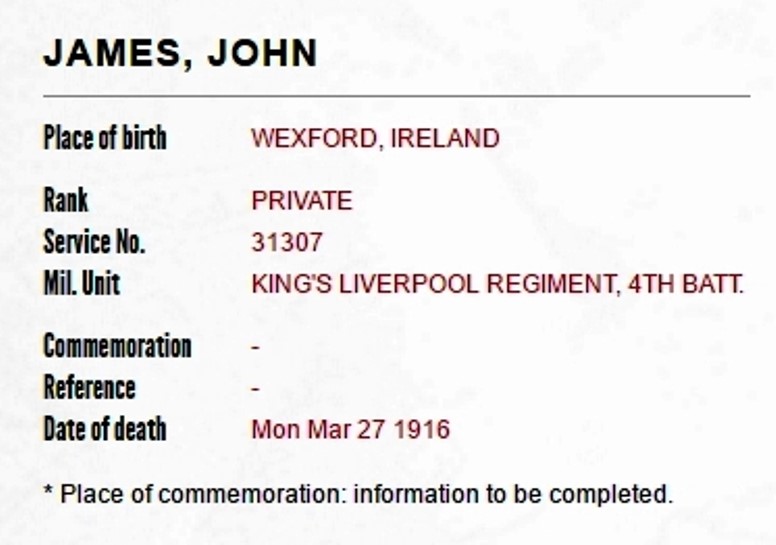
Memorial for John James of County Wexford. Courtesy Ireland’s Memorial Records.
Another website, Ireland’s World War I Veterans 1914-1918, has created a PDF list, updated every three months, which contains over 35,000 names of Irishmen who fought in World War I. If you know or suspect your Irish ancestor may have served in World War I and survived the experience, this is an excellent place to find a clue about his origins.
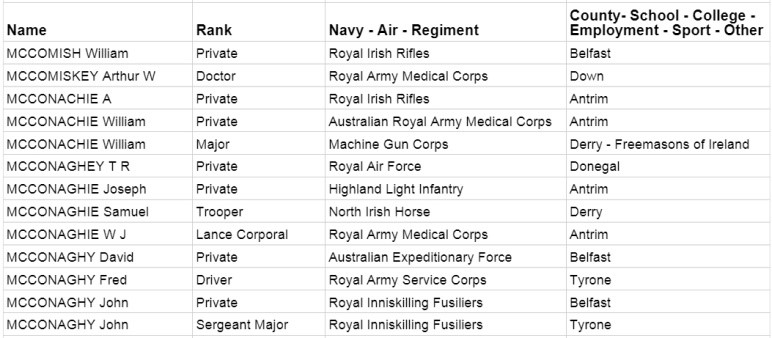
A sample of the list of those who served as created by Ireland’s World War I Veterans 1914-1918.
Although it can be difficult to find the correct place in Ireland for your family’s origins, there are some important clues, both historical and geographical, that can help you pinpoint a place to begin your search in Ireland.
Trace Your Irish Ancestors: In Conclusion
 The 1930 U.S. census can provide an important clue to trace your Irish ancestors, as can your family’s religious heritage. If an Irish ancestor served in World War I, you may be able to determine the county in which he was born. A knowledge of the differences between Northern Ireland and the Republic of Ireland, as well as their location and the counties within those two countries, can help you contact the proper vital records office for those all-important vital records. So, go n-éirí leat! Good luck!
The 1930 U.S. census can provide an important clue to trace your Irish ancestors, as can your family’s religious heritage. If an Irish ancestor served in World War I, you may be able to determine the county in which he was born. A knowledge of the differences between Northern Ireland and the Republic of Ireland, as well as their location and the counties within those two countries, can help you contact the proper vital records office for those all-important vital records. So, go n-éirí leat! Good luck!
The team of expert genealogists at Legacy Tree Genealogists can help bust through your brick walls. They do the research and you enjoy the discoveries!
